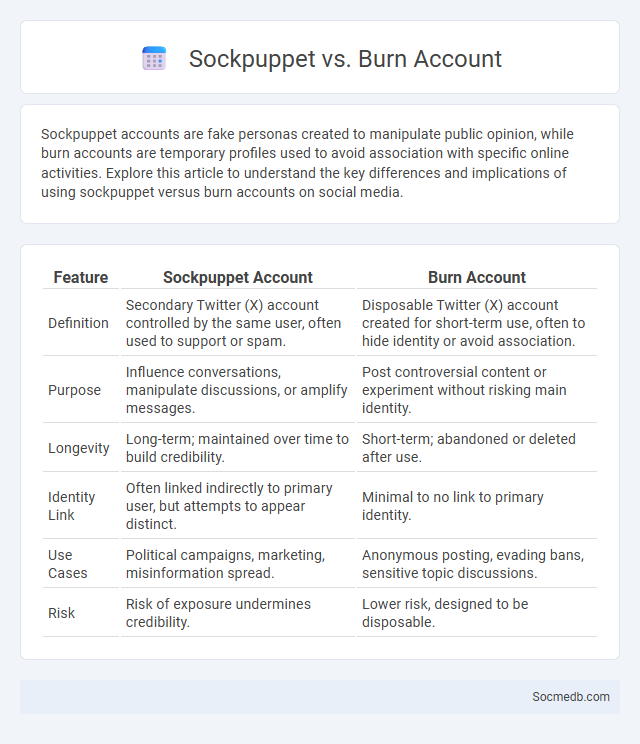
Photo illustration: Sockpuppet vs Burn Account
Sockpuppet accounts are fake personas created to manipulate public opinion, while burn accounts are temporary profiles used to avoid association with specific online activities. Explore this article to understand the key differences and implications of using sockpuppet versus burn accounts on social media.
Table of Comparison
| Feature | Sockpuppet Account | Burn Account |
|---|---|---|
| Definition | Secondary Twitter (X) account controlled by the same user, often used to support or spam. | Disposable Twitter (X) account created for short-term use, often to hide identity or avoid association. |
| Purpose | Influence conversations, manipulate discussions, or amplify messages. | Post controversial content or experiment without risking main identity. |
| Longevity | Long-term; maintained over time to build credibility. | Short-term; abandoned or deleted after use. |
| Identity Link | Often linked indirectly to primary user, but attempts to appear distinct. | Minimal to no link to primary identity. |
| Use Cases | Political campaigns, marketing, misinformation spread. | Anonymous posting, evading bans, sensitive topic discussions. |
| Risk | Risk of exposure undermines credibility. | Lower risk, designed to be disposable. |
Understanding Online Identities: Sockpuppets and Burn Accounts
Social media platforms are often manipulated through sockpuppets, which are fake profiles created to deceive or influence online conversations. Burn accounts serve as temporary or disposable profiles used by individuals to protect their true identity or avoid repercussions from controversial posts. Understanding these online identities helps you navigate digital interactions more safely and discern authentic engagement from deceptive activities.
Defining Sockpuppets: What Are They?
Sockpuppets are fake online identities created to manipulate opinions, deceive users, or amplify specific agendas on social media platforms. These accounts often appear legitimate but are controlled by the same individual or group to create the illusion of widespread support or consensus. Detecting sockpuppets involves analyzing behavior patterns, IP addresses, and content similarities to maintain social media integrity.
Burn Accounts Explained: Key Characteristics
Burn accounts are social media profiles created for anonymity and temporary use, often lacking personal identifiers or consistent content. These accounts enable users to explore different viewpoints, share sensitive information, or engage online without linking back to their real identity. Understanding these key characteristics empowers you to recognize burn accounts and maintain digital privacy effectively.
Sockpuppet vs Burn Account: Core Differences
Sockpuppet accounts are created to deceive others by pretending to be different individuals, often used to manipulate opinions or evade bans on social media platforms. Burn accounts, on the other hand, are temporary profiles typically used for one-time or short-term purposes, such as private messaging or anonymous browsing, without an intent to maintain long-term identity. Understanding your use case helps differentiate whether you need a sockpuppet for covert influence or a burn account for disposable anonymity.
Common Motives Behind Using Sockpuppets
Users create sockpuppets on social media to manipulate public opinion by amplifying support or dissent, often hiding their true identity. These fake accounts facilitate deceptive activities such as spreading misinformation, evading bans, or conducting astroturfing campaigns to simulate grassroots movements. Social media platforms face challenges detecting sockpuppets, as they exploit algorithms and user trust to influence engagement metrics and online discourse.
Why Users Create Burn Accounts
Users create burn accounts to maintain privacy and experiment with different online personas without linking back to their main profile. These accounts allow people to express controversial opinions, share sensitive information, or explore niche interests without fear of judgment or repercussions. Your ability to manage multiple identities helps control your digital footprint and protect personal boundaries in social media environments.
Ethical and Legal Implications
Social media platforms present complex ethical and legal challenges, including concerns over data privacy, misinformation, and user consent. You must navigate regulations like GDPR and COPPA to ensure compliance and protect user rights. Ethical practices also demand transparent content moderation and respect for intellectual property to maintain online trust.
Detection and Prevention Techniques
Detection and prevention techniques for social media threats rely heavily on AI-driven algorithms analyzing user behavior patterns and content for signs of spam, fake accounts, or malicious activity. Machine learning models continuously update to identify emerging threats such as deepfake videos, misinformation, and phishing attempts, enhancing platform security. Real-time monitoring systems combined with user reporting mechanisms provide a robust framework to mitigate risks and maintain trust across social networks.
Impact on Online Communities
Social media transforms online communities by enabling real-time interaction, fostering diverse connections across geographical boundaries, and facilitating the rapid exchange of information. It amplifies user engagement by creating spaces for shared interests, collaborative problem-solving, and collective activism. Your participation shapes the dynamics, influence, and cultural evolution of these digital communities.
Best Practices for Authentic Engagement
Fostering authentic engagement on social media requires consistent interaction through genuine comments, timely responses, and personalized messages that resonate with the audience. Leveraging user-generated content and storytelling enhances credibility while encouraging community participation and trust. Aligning content with audience values and using data-driven insights from platforms like Instagram Analytics or Facebook Insights optimize reach and engagement rates.
 socmedb.com
socmedb.com